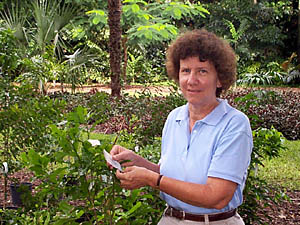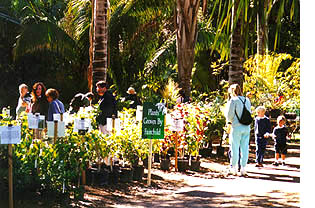In Pursuit of Plant Excellence
by Mary Collins, Senior Horticulturist

The selection of plants for our sales is never far from my mind. I constantly observe plants growing in the Garden, noting their characteristics. For example, "Are they adapted to South Florida soils, or do they need regular applications of iron?" Then there are questions we must ask to make sure that we do not introduce an exotic plant that will invade our natural areas. "Does the plant (if not native to South Florida) produce many seeds? Do the seeds germinate readily under the plant? Have we noticed seedlings elsewhere in the Garden or in areas surrounding the Garden?"
In some cases I and fellow staff members plant newly introduced exotic plants in our own yards to observe their growth, seed production and proclivity to produce seedlings – anything which would increase their chances of becoming a pest plant. We also observe them to determine how successfully they grow in our soils and climate. Are they adapted to our alkaline soils? Do they show cold damage when exposed to temperatures in the 40's? Our intent is to distribute plants that are easily grown in our climate yet do not pose the risk of becoming a pest plant, displacing native flora.
We have a large number of species native to South Florida and the Caribbean growing in the garden. After years of observation, I have become increasingly drawn to the Bahamian plots, Plots 164 and 166. Many of the Bahamian plants also are native to South Florida. Through hiking, my favorite pastime (next to gardening, of course), I observe the plants that grow in the pinelands, glades, and hammocks of South Florida. What incredible plants! Many are drought tolerant, flood tolerant, fire tolerant, pest free, produce food for our native birds and butterflies and thrive in our alkaline soils.
With today's busy lifestyles, people have less time to give special treatments to their plants. For them, natives are ideal. Many are small to medium sized and require little if any pruning. Plant, water while establishing, lightly fertilize, then leave them alone.

Although we have this rich palette of easy-care native trees, shrubs, and herbaceous plants, we seldom see them grown in the landscape. Why not? Some natives are slow growing, thus are less apt to be grown commercially. Propagation of natives may be difficult; determining the best technique to use is only the first hurdle. Locating a seed source can also be a challenge; it is illegal to collect in national parks, state, or county property. In some cases we are perplexed as to how to get the seeds to germinate. A prime example is wild cinnamon bark, Canella winterana. Native to South Florida and the West Indies, it is a beautiful tree producing small red-purple flowers and bright red, velvety soft fruits. It is difficult to propagate vegetatively, and its seeds are slow to germinate. Ten to twenty percent germination rate is about all we have expected.
For several years, I have been trying to get enough seedlings for distribution to Garden members from the two mature specimens of cinnamon bark that grow in the Garden. To determine the best conditions for seed germination, I wanted to see where the trees grew in the wild. Although rare in South Florida, I knew they could be found in areas of Everglades National Park, so I asked a friend to show me the plants there. Last March I saw the limited area where they grow and noticed the individual trees were of all sizes and ages. I also noted the growing conditions. Later that month I noticed that the fruits on our trees were rapidly disappearing . . . birds? I quickly collected both ripe fruits and full-sized green fruits. I immediately cleaned the seeds and planted them on the surface of a very well drained media, mimicking that in their natural environment. Within two weeks germination had begun, surprisingly, with no noticeable difference between seeds from ripe and unripe fruits. Although germination was far from 100 percent, we should have enough plants for distribution to members in two or three years.
My latest home project is growing native wildflowers, purchased from a local nursery, so I can see how they are adapted to conditions not exactly like their native habitats. Their beautiful flowers, yellow, purple, blue, have the potential to give more color and interest to our landscapes. I will use the knowledge gained from this project to increase the number and variety of native wildflowers available at our sales.
I continue to work with and observe plants in the Garden as well as my own yard, consult with other Garden staff, local experts and scientists to provide interesting and lesser known plants to Garden members and the public at the Garden's sales, leading gardeners down the path to a joyous, rewarding experience.
Garden News, November 1999